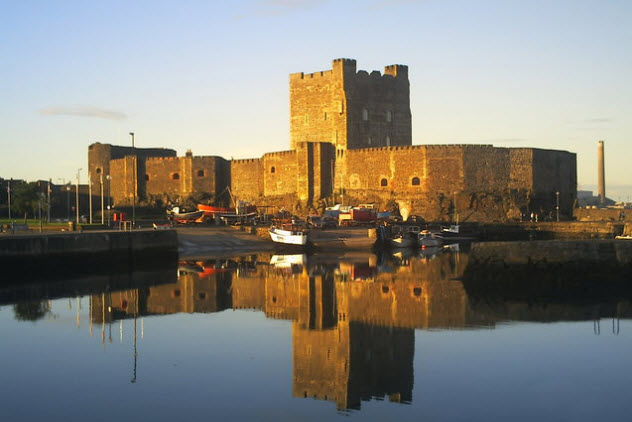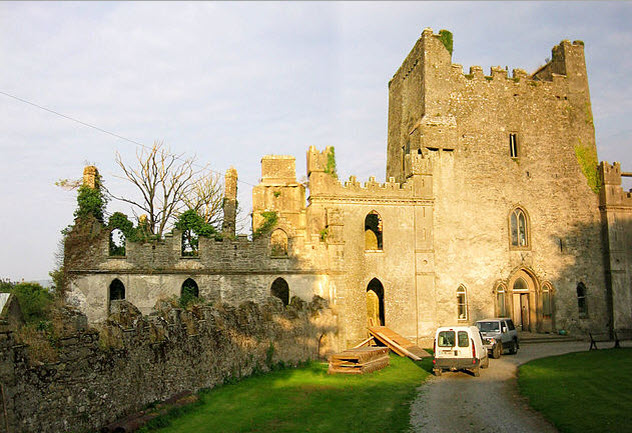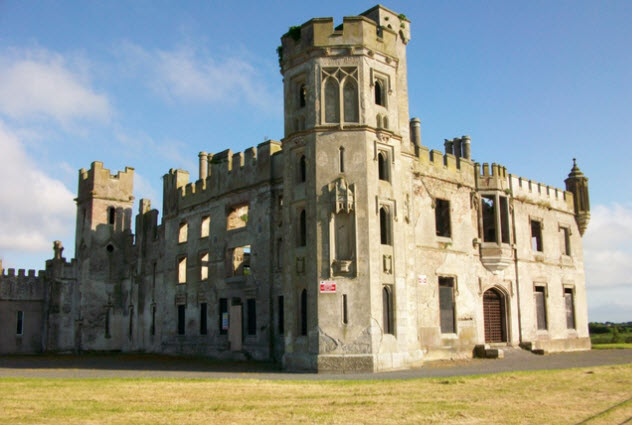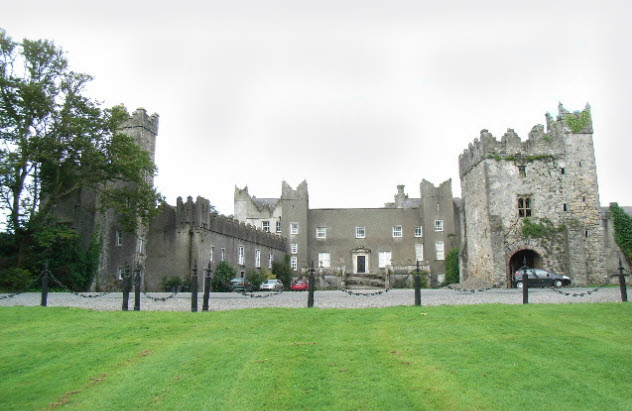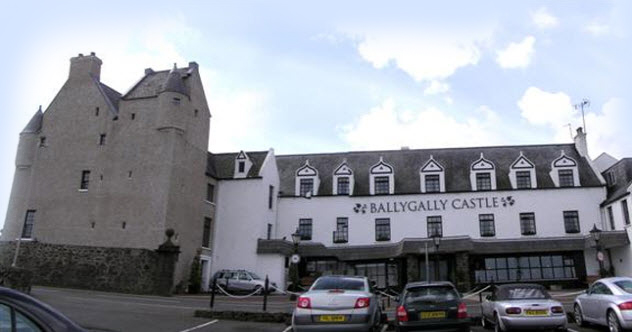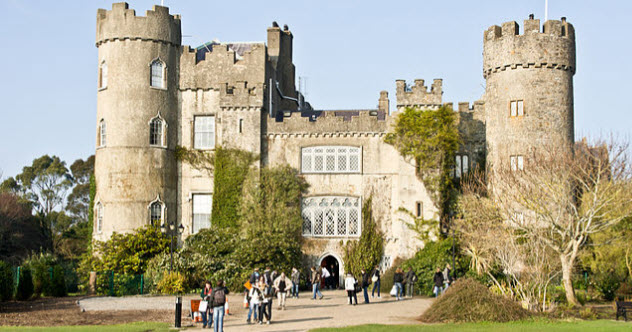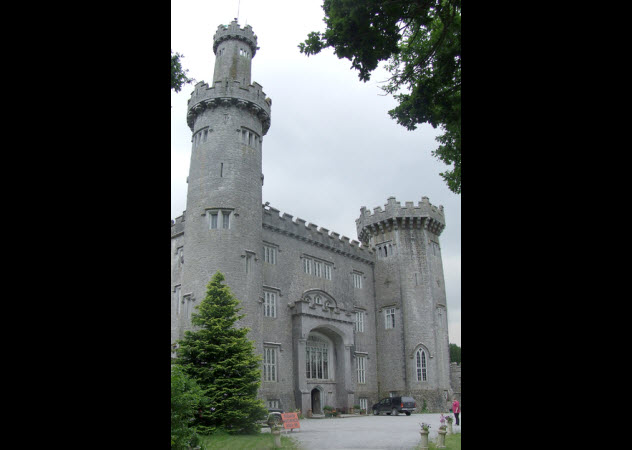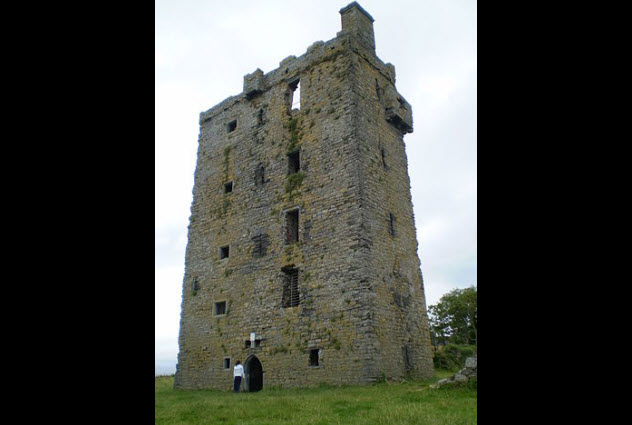10 Carrickfergus CastleCounty Antrim
Carrickfergus Castle is an impressive Norman stronghold located just outside Belfast in Northern Ireland. Built between 1180 and 1205, the castle has been occupied by the Irish, English, Scottish, and even the French due to its strategic location on the northeast coast. Over the years, the castle has seen more than its fair share of death and violence, which has led to a number of alleged ghosts wandering its grounds. But none is more famous than the spirit affectionately known as “Buttoncap,” who is named after the distinctive large button on his hat. In the mid-18th century, an English soldier named Robert Rainey was stationed at Carrickfergus Castle, where he met and fell in love with a woman by the name of Betsy Baird. Unfortunately for the lovesick soldier, Betsy was allegedly having an affair with another man. Rainey found out about the affair and killed the man responsible. As he lay dying, the victim told his brother what had happened. His brother just happened to be Lieutenant Colonel John Jennings, the commanding officer of Carrickfergus Castle. However, it was not Rainey who was identified as the killer but Timothy Lavery, another soldier and personal friend of Rainey. Despite Lavery’s protests of innocence, his resemblance to Rainey caused him to be sentenced to death. Lavery declared that he would haunt the castle because of this injustice. Many people believe that he was hanged, as this was the preferred method of execution at the time. However, it is possible that another of the castle’s ghosts is Buttoncap. There have also been sightings of a drummer boy who was supposedly thrown down a well to his death. Lavery also acted as one of the castle drummers, so many people have reported seeing him at the well that is now referred to as Buttoncap’s well. Could people be confusing the two ghosts, or was Lieutenant Jennings so distraught over his brother’s death that he ordered a special form of execution for the supposed killer?
9 Leamaneh CastleCounty Clare
Leamaneh Castle is a 17th-century castle in the west of Ireland that is said to be haunted by the ghost of a woman known as Maire Rua (“Red Mary”). The name refers to the color of her hair, which is an odd nickname considering that Ireland is full of red-haired women named Mary. Born in 1615, Maire was a well-to-do woman who had three husbands and 13 children during her lifetime. She took her first husband, a wealthy landowner, at age 15, but he died several years later. It was during her marriage to her second husband, a cousin of hers named Conor O’Brien, that the castle was built. All seemed to be going well for Maire and her gaggle of children. Then Conor died while leading a failed rebellion against Oliver Cromwell, the most hated and genocidal maniac in Irish history. Knowing that her estate would be seized because of her husband’s actions, Maire rushed out and married John Cooper, one of Cromwell’s officers. The fact that each of her marriages was so beneficial to her caused people to spread rumors that Maire was a promiscuous woman. It was said that she slept with a different soldier each night before having them killed. Supposedly, she had about 25 husbands whom she had killed in evil ways, such as forcing them to ride a horse off a cliff. It is a fact that she was a powerful woman. She was born into a powerful family, married powerful men, and had powerful friends. So it only makes sense that she also had powerful enemies. One day, these enemies are said to have risen up against Maire and trapped her in a hollow tree. Unable to escape, she eventually perished. Her red-haired ghost haunts Leamaneh Castle to this day.
8 Leap CastleCounty Offaly
While it is not known exactly when Leap Castle was built, it is probably at least 500 years old. The castle has housed many powerful people through the centuries. One such person was Teige O’Carroll, who murdered his priest brother in what is now known as the Bloody Chapel. Another ghost that haunts the castle is known as the Red Lady, who may be the spirit of a woman who was kept in the oubliette, a dungeon that can only be accessed through a trap door. According to the castle’s website, she became pregnant by one of the O’Carroll men, who then murdered the child, driving her to commit suicide. Another theory states that the Red Lady is the ghost of Mrs. Darby, who freed her lover from the O’Carrolls’ dungeon by inciting a bloody battle that resulted in Darby seizing the castle. The Darby family then spent over 200 years residing in Leap Castle. At the end of the 19th century, Jonathan Darby found three standing skeletons bricked into the walls of the castle. Being a reasonably prudent man, Darby concluded that the skeletons must have been put there for a reason and bricked them right back up. More skeletons were found throughout the grounds over the next few decades. There are a number of other ghosts that are said to haunt the castle, such as an old man, two little girls, and their nanny. But all of them pale in comparison to what is referred to as “the elemental.” Mildred Darby, who frequently held seances at the castle, described the elemental in an occult magazine: “The thing was about the size of a sheep. Thin, gaunting, shadowy . . . its face was human, to be more accurate inhuman.” She went on to say that it had decomposing eyes and smelled like a rotting corpse. The castle lay empty for over 50 years but is now occupied by the Ryan family. They have had numerous paranormal investigative teams in, such as The Atlantic Paranormal Society and the crew of Most Haunted.
7 Loftus HallCounty Wexford
Originally called Redmond Hall, Loftus Hall was built in 1350 by the Redmond family and renamed after it was acquired by the Loftus family 300 years later. It wasn’t until 1766, however, that the estate was cursed with a supernatural presence that remains to this day. Back then, it was not unusual for sailors to seek shelter in houses during a storm. So when a stranger came looking for a place to stay, the Tottenham family, the residents at the time, opened their doors. The storm is said to have gone on for weeks. During this time, the stranger grew close to Anne, one of the Tottenham daughters. He frequently played cards with the family in the evenings until one night when Anne dropped a card beneath the table. When she bent down to retrieve it, she realized that her new beau had hooves instead of feet. Realizing that the man was actually the Devil, Anne began screaming. Immediately, he transformed into a ball of fire and burst through the ceiling. Of course, the presence of the Devil left an otherworldly scar on Loftus Hall, which is blamed for the violent and ghostly goings-on that have occurred since. An exorcism was conducted but did not solve the problem. Anne was so traumatized by the experience that she lost her mind and was locked up for 19 years until she died. Her spirit also haunts the grounds, incapable of coming to terms with what transpired. A photo taken by a tourist in 2015 supposedly shows Anne’s ghost beside that of an older woman. In 2011, a team of paranormal researchers even made a documentary about Loftus Hall. But the cherry on top of the story is that this is a special year for Loftus Hall, which is celebrating its 666th birthday. To honor this once-in-an-eternity event, the good people at Loftus Hall will lock you inside from 8:30 PM to 3:30 AM for just €66!
6 Duckett’s GroveCounty Carlow
Although it has deteriorated over the years, Duckett’s Grove is definitely one of Ireland’s most beautiful castles. With a demesne of almost 50 square kilometers (20 mi2), Duckett’s Grove was originally the site of the Duckett family house. Then it underwent a major redesign that transformed it into a spectacular Gothic Revival castle by 1830. There is no indication that anyone lived in the castle other than the Duckett family, many of whom apparently still reside there in death. All sorts of strange apparitions have been reported, such as ghosts working in the kitchen and sightings of what is known as the Death Coach. But while many people have claimed to see ghosts of either the Duckett family or their servants, it is the castle’s resident banshee that makes it famous. Although they are a type of fairy, banshees are created by transforming ghosts and will typically only follow the families of people to whom they were close during life. In the case of the Duckett’s Grove banshee, it is believed that she is the spirit of a woman who was having an affair with William Duckett. She died tragically while riding one day. The woman’s mother, most likely ashamed of her daughter and angry at the Duckett family, used a widow’s curse to turn the deceased into a banshee that would haunt the family forevermore. Since then, a number of people claim to have heard her wailing, sometimes for days on end, to warn of an impending death. Although the Duckett family had lived at the grove for around 100 years and had been a powerful family in the area for over 300 years, William’s wife, Maria, was the last member of the Duckett family to live there, swiftly abandoning the estate in 1916. In 1933, the castle inexplicably burned down and lay in ruin until it was acquired by Carlow County Council in 2005, which began restoring it to its former glory. Maria died in 1937, and her only daughter, Olive, became embroiled in a legal battle for her inheritance. A deal was struck where Olive could collect the interest on a portion of her mother’s money, but it would be handed back to the legal estate after she died. This is how the once-powerful Duckett family was brought down. The Duckett family motto is Spectemur agendo (“Let us be judged by our actions”), and it appears that they were.
5 Howth CastleCounty Dublin
Although Howth Castle has been continuously occupied by the St. Lawrence family for almost 800 years, the majority of the present structure is less than 600 years old. Inside, there is a painting of Nicola Hamilton that has a note attached to the back. The note claims that a black ribbon was originally painted on the woman’s wrist, but it disappeared while the painting was being cleaned. Nicola had a lifelong friendship with a man named John Le Poer (aka Lord Tyrone). The two were unrelated orphans who were raised together until their early teens. They remained close all their lives and agreed that whoever died first would come back and tell the other about the afterlife. Lord Tyrone died first. A woman had appeared at the foot of his bed with a robin redbreast sitting on her finger and told him that he would die at midnight in three days’ time. Sure enough, Lord Tyrone was found dead three days later, his watch frozen at just after 12 o’clock. There was speculation that he had taken poison to fulfill the prophecy himself. A few nights later, Nicola awoke to see his ghost at the foot of her bed. Not realizing that he was dead, she asked what he was doing. He informed her that he had died and was granted permission to come back and tell her three things: Nicola was pregnant with a son who would marry his daughter, Nicola would remarry after her current husband died, and she would die at age 47 while giving birth to her second husband’s third child. Afraid that she would believe that this was just a dream, the ghost of Lord Tyrone grabbed her wrist and left it permanently scarred. The next morning, she covered her wrist with a black ribbon that she would wear for the rest of her life because Lord Tyrone had forbidden her to let anyone else see the scar.
4 Ballygally CastleCounty Antrim
Ballygally Castle is a 17th-century castle just outside the coastal town of Larne in Northern Ireland. Now operating as a hotel, the original structure is said to be haunted by the ghost of a woman named Lady Isobel Shaw, whose husband, James, built the castle in 1625. James locked Isobel in one of the castle turrets before having her thrown either out the window or down the stairs. He had apparently discovered that she was having an affair with a sailor, who may have been the real father of Isobel’s daughter. Many people have claimed to experience paranormal events in and around this room, now called the Ghost Room, but none of them better than the experiences of Kim Lenaghan. Kim is a TV and radio broadcaster who works with the Northern Irish branches of the BBC, such as BBC Radio Ulster. As part of a Halloween series, Kim decided to meet a medium, simply known as Sally, and stay overnight in the hotel. In the Ghost Room, Sally attempted to make contact with a castle spirit. According to Kim, three things happened simultaneously: Sally started talking to an obviously distressed woman, there was a sudden stench of “old, musty vanilla,” and the temperature of the room began to increase significantly. During the experience, which lasted almost 10 minutes, Sally believed that the spirit was being held captive and kept calling out to sea for a man named Robert. When Sally lost contact, the smell disappeared and the temperature returned to normal. Even though Sally left, the shaken Kim resolved to stay the night in the Ghost Room, something few people do. At 3:00 AM, the temperature soared again and the smell returned. Kim started to record notes on her tape recorder but quickly decided to flee the scene instead. The next day, the manager told her that other guests in that part of the castle had been disturbed by late-night knockings. One had even claimed to see an unknown woman in their room. Finally, Kim returned to the Ghost Room, whereupon she saw her name written on the mirror. She isn’t sure if that last part was a prank. Luckily, Ireland and Northern Ireland aren’t big places. So the author of this list asked Kim if this really happened. As shown on her Twitter feed, she said that this story is “pretty much exactly as it happened.”
3 Malahide CastleCounty Dublin
Considered to be one of Ireland’s greatest castles, Malahide Castle was built by Richard Talbot at the end of the 12th century. The Talbot family remained in Malahide Castle for nearly 800 years. Then Rose Talbot decided that she could earn herself a tidy sum by killing that nearly millennium-old legacy and selling the castle. She also sold much of the furniture separately. Thankfully, the government purchased the castle and retrieved as much of the original art and furniture as it could. The castle is now open to the public. The castle has no shortage of ghosts, with some fairly unusual specters roaming the grounds. The most famous example is Puck, an ugly dwarf who worked as the court jester and lived in one of the towers in the 16th century. There are tiny doors dotted around the castle that Puck allegedly uses to get around. Then there is the ghost of Walter Hussey, who wanders around pointing to the spot where he was fatally wounded in battle. The day that he died was also the day that he had gotten married. His wife is now described as being a “maid, wife, and widow in one day.” This unfortunate woman was Maud Plunkett, whose ghost can be seen chasing the ghost of another husband around the castle. Another ghost is that of Miles Corbett, who occupied the castle on behalf of Oliver Cromwell during the Cromwellian conquest of Ireland. Unfortunately for Miles, the Irish really hate being invaded. During the Restoration of 1660, he was hanged, drawn, and quartered. This means that he was tied to a horse and dragged to the gallows. There, he was hanged, emasculated, disemboweled, beheaded, and chopped into four pieces. This explains why those who see his ghost say that he appears as a knight who gruesomely falls apart. Lastly, there is a painting of an unknown woman in the castle, and her ghost is said to wander the grounds. Overall, the White Lady is just your average ghost, although it has been said that she can climb out of her own painting.
2 Charleville CastleCounty Offaly
Charleville Castle is a large, Gothic Revival–style castle that was built in the late 18th and early 19th centuries. Surrounded by a forest, it is considered to be one of the most beautiful castles in Ireland and is said to be haunted by the ghost of a little girl named Harriet. Harriet lived in the castle until her tragic death at just eight years old. In 1861, she was sliding down the banisters of the main staircase but lost her grip and fell to the stone floor below, possibly a three-story drop. There have been numerous sightings of Harriet’s ghost over the years, and many people believe that they have captured her in photographs. She is usually seen around the fatal staircase, although she has been reported all over the castle. Harriet is described as a blonde girl with blue ribbons and a blue-and-white dress. She is usually seen alone, although she is sometimes accompanied by the ghost of an unknown little boy. But she is not always visible. Some people have reported only hearing her singing or laughing in the castle. Her parents were so devastated by their loss that they had a protective railing placed along the staircase to prevent any future accidents. While this is now gone, its markings can still be seen today. There is also the story of a mystical tree that is still located on the castle grounds. Legend has it that the falling of a branch from this tree, an impressive King Oak, foretold the death of a member of the Bury family. A few days after the tree was struck by lightning in 1963, the last member of the Bury family died. His ghost is also said to haunt the castle.
1 Carrigaholt CastleCounty Clare
Estimated to have been built around 1480, Carrigaholt Castle now lies in ruin and has largely faded into obscurity. As Ireland has such an overwhelming number of castles, ruins like this tend to blend into the background as everyone goes about their business, indifferent to the centuries of history that took place within its walls. The castle, also known as McMahon Castle after its original owners, has been abandoned for over 100 years. It is no longer possible to go inside, but the castle is said to be occupied by a force so malevolent that few people are brave enough to chance it anyway. Even paranormal investigators, who have visited every other castle on this list, are said to steer clear of Carrigaholt. Like many others in Ireland, this castle comes equipped with a murder hole, a concealed tunnel that runs from the upper levels down to the main entrance to allow defenders of the castle to drop things like burning oil on intruders. Although “murder hole” might sound macabre, it is this sealed room within the castle that is said to be the hiding place for the evil force that dwells within. The last known time that anyone entered the room was in the 1920s, when an exorcist opened it to rid the castle of all evil once and for all. He was no match for the power within, however, and was literally scared to death during the night. He was found the next day, his face indicating that he had died in a state of unimaginable fear. The room has been sealed ever since. Nobody knows exactly what resides in the sealed chamber. It could be a spirit, a banshee, a demon, the Devil, or just some form of “energy.” Whatever it is, it’s probably best to leave it alone. Simon still enjoys Irish stereotypes such as drinking, loving the potato, and legalizing same-sex marriage by popular vote. Any guys interested in having a legally recognized wedding in an Irish castle can contact him on Twitter.
